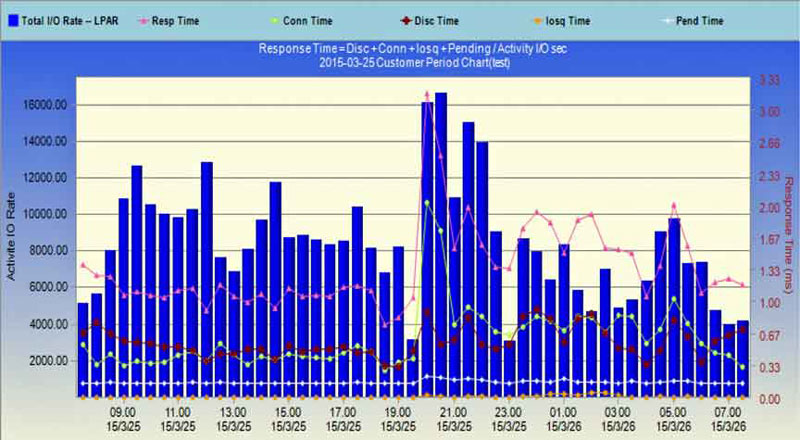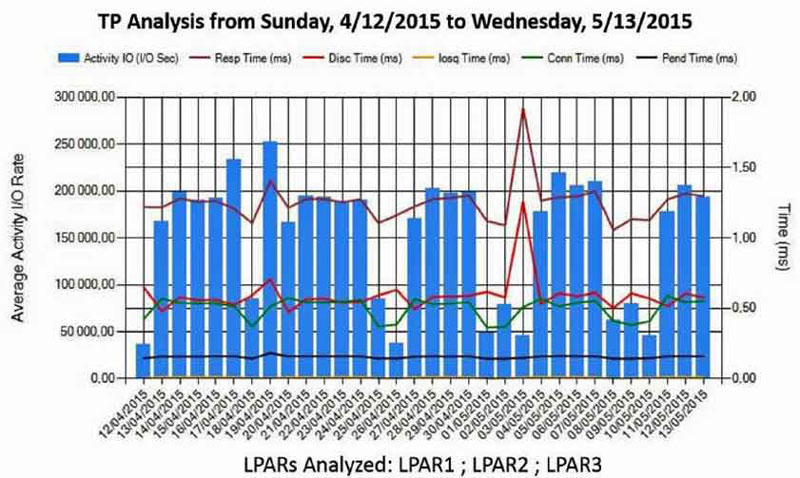

EADM is a simple and innovative solution that monitors z/OS DASD performance and I/O behaviour.
Every day, EADM automatically analyzes disk performance and Workload manager metrics from RMF data. EADM produces user friendly dashboards specially designed for the z/OS storage team to help them implement a proactive performance management strategy.
Disk storage is one of the largest line items in modern data centres. Maintaining fast and reliable access to enterprise data is essential. Properly monitoring an ever more complex z/OS infrastructure can be challenging because many enterprises simply lack the resources to do so on a regular basis. While a single z13 mainframe CPU can process over one hundred million transactions per hour, daily changes in hardware and software configuration create availability risks and can jeopardize SLAs.
Previously there was a very simple synergy between the IBM mainframe and its disk I/O subsystem (DASD). There was simply a direct connection between the mainframe and the physical disk (3390). Over the years, major improvements in DASD subsystems added many layers of technology (Cache, Memory, FICON Channels, RAID Storage, Proprietary Microcode, etc.).
From a DASD subsystem viewpoint, there is no longer an obvious one-to-one direct connection. An increasing number of technological advances, both microcode and hardware (Memory, Fibre Channel, Function Assist Processing, etc.) have reduced the requirement for accessing the data directly from the physical device. Modern mainframe incorporates multiple cache level CPU chips (Relative Nest Intensity), substantial processor memory resources, high-bandwidth Fibre Channel subsystems (FICON, zHPF) and a hierarchy of DASD memory (SSD/Flash, Cache).
With this new technology, it’s not uncommon to consider an I/O that requires a physical device access as a problem!
This new technology introduces greater complexities in managing disks I/O subsystem. Performance Analyst must now gather meaningful information from an ever-increasing amount of performance data.
EADM is an automated Storage Performance Management tool for z/OS DASD I/O Subsystem. It is specially designed for z/OS mainframe Storage Managers, Systems Engineers, Service Managers and Capacity/Performance Analysts. EADM significantly reduces time spent on searching for I/O incidents. EADM has three main objectives:
Real time monitoring does not allow for in-depth detection of bottlenecks and system glitches that impact performance. Often, when an alert is issued, the mainframe availability has already been disrupted. Traditional storage performance tools are no longer adequate to provide pertinent and predictive information, especially when dealing with large complex LPAR configurations.
EADM performs an automated and intelligent daily health check of the entire mainframe disk I/O subsystem. EADM automatically delivers customize user friendly reports via e-mail. Operations and performance analysts are alerted as soon as performance variances occur, typically in minutes.
EADM produces a number of meaningful reports allowing z/OS analysts to effectively manage the DASD I/O subsystem.
Incorporating meaningful performance indicators, with drill-down and zoom-in ability, storage analysts can easily determine if the problem is temporary, permanent, local or global. Using EADM, technical analysts can efficiently manage the ever increasingly complex DASD environment. The information contained in the EADM reports eases communications with internal business teams and external suppliers alike.

Daily I/O Profile Summary shows components I/O operations for easy identification of performance issues
EADM automatically analyzes RMF/CMF data, retaining pertinent data necessary to create an intelligent repository of I/O and storage behaviour necessary for optimal performance and capacity planning. EADM allows z/OS analysts to make the right decisions, take proactive action, reduce service outage risks and optimize the cost of ownership (TCO).

Monthly I/O Workload (Online and Batch) showing I/O activity and response time for an LPAR group
Maintaining a well-tuned z/OS disk subsystem is essential for in today’s ever-increasing storage requirements of mission critical business applications. A poorly performing I/O subsystem generates unnecessary CPU overhead causing potential TCO and business impacts. While z/OS servers and its underlying DASD I/O subsystem can compensate for application code or data placement issues, the fundamental concept of analyzing and tuning the I/O subsystem remains. EADM delivers the following benefits:
EADM significantly reduces the time spent on finding solutions related to I/O incidents. Detailed reports that previously took two days to prepare are now created in only two minutes.
For more information on EADM, please fill our contact form or send us an email.
SenmeSoft represents several software solution publishers in Canada. Our innovative solutions are primarily aimed at large enterprises. Our solutions meet the management’s requirement for streamlining.
Our software solutions improve productivity and offer more flexibility. Our performance and capacity planning solutions help manage and control resource utilization and quickly detect any anomalies. Our Db2 tools manage and copy databases in a fraction of the time normally required.
✉ Email
info@senmesoft.com
Copyright © 2003-2025 Senmesoft Inc. All Rights Reserved.